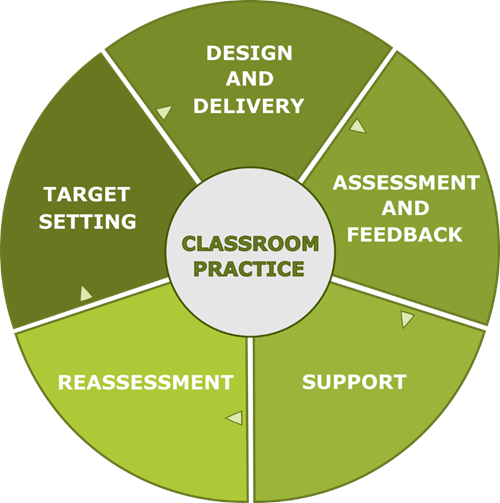Section 3: INCLUSIVE CLASSROOM PRACTICE
Knowing learners and their needs is crucial for teachers and other educational staff to plan and provide learners with holistic learning experiences, so that they enable learners to attain achievable yet challenging goals successfully. This requires educators to create an inclusive class environment in which learners feel safe to make mistakes. Also, they need to employ a range of appropriate teaching, learning and assessment approaches to meaningfully engage learners and meet their needs. Providing effective feedback to stimulate progress in learning is essential. The questions below might help teachers and other educational staff reflect on how well their pedagogy and approaches serve to reduce barriers and provide engaging learning experiences.

- How well do teachers and other educational staff know their learners, and in particular their specific educational, social and emotional learning needs? How well do teachers support the emotional wellbeing of learners?
- How effectively do teachers and other educatonal staff use learners’ starting points to set achievable and challenging short, medium and long-term goals?
- How successfully do teachers and other educational staff create an inclusive and safe environment, in which all learners feel confident to participate in learning and take risks?
- How well do teachers, and other educational staff where appropriate, plan lessons and activities that lead to meaningful learning experience for all learners?
- How well do teachers and other educational staff work collaboratively to plan and facilitate learning to meet the needs of all learners?
- How successfully do teachers and other educational staff employ a range of appropriate teaching, learning and assessment approaches that stimulate successful learning and development?
- How well do teaching and learning activities build on and complement each other to achieve learning, social or emotional goals?
- How well do teachers and other educational staff help learners to develop learners’ language and digital literacy skills necessary to access learning, and express their ideas, thinking, and emotions appropriately?
- How well do teachers and other educational staff help learners to understand the learning process and develop effective learning strategies, higher-order thinking and problem-solving skillsHigher-order thinking skills (HOTS) is based on various taxonomies of learning, particularly the one created by Benjamin Bloom in 1956. Bloom’s taxonomy was designed with six levels to promote higher-order thinking. The six levels were remembering, understanding, applying, analyzing, revising, and creating. The lower-order thinking skills (LOTS) involve memorization, while higher-order thinking requires understanding and applying that knowledge.?
- How well do teachers and other educational staff build on the strengths of each learner to develop their confidence continually?
- How well does questioning probe and develop learner’ knowledge to deepen their understanding?
- How well do assessment and feedback practices ensure appropriate progress in learning and inform the next steps in teaching and learning, particularly for vulnerable learners?
- Where digital technology is used, how effectively is such technology used to reduce barriers, engage learners, ensure strong progress in learning and provide meaningful feedback?
- How well do teachers and other educational staff monitor the impact of any feedback or support given? How well do they adjust their approaches or provide appropriate support in light of feedback and assessment?
- How accuartely do teachers and other educational staff self evaluate the impact of their practices on learning and learners’ social and emotional needs? Do they modify their approaches appropriately in light of this self-evaluation?
- How well does the school adapt its classroom practices in unexpected and challenging situations, for example during unexpected school closures and in distance and blended learning environments to secure continuity in learning for vulnerable learners?